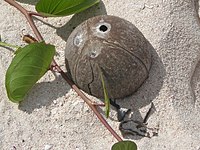
Coconut trees on the coast, Falealupo village, Savai'i Island, Samoa

Coconuts
Sina and the Eel is a legend in Samoan mythology[1] which explains the origins of the first coconut tree.[2]
In the Samoan language the story is called 'Sina ma le Tuna.'[3] 'Tuna' is the Samoan word for 'eel'.
The story is also well known throughout Polynesia including Tonga, Fiji and Māori in New Zealand.[4]
Different versions of the legend are told in different countries in Oceania.[4] The coconut tree (Cocos nucifera) has many uses and is an important source of food. It is also used for making coconut oil, baskets, sennit rope used in traditional Samoan house building, weaving and for the building of small traditional houses or fale. The dried meat of the coconut or copra has been an important export product and a source of income throughout the Pacific.
The legend of Sina and the Eel is associated with other figures in Polynesian mythology such as Hina, Tinilau, Tagaloa and Nafanua.
Sina is also the name of various female figures in Polynesian mythology. The word sina also means 'white' or silver haired (grey haired in age) in the Samoan language. There is also an old Samoan song called Soufuna Sina based on a Sina legend.[5]

Coconut shell showing the 'two eyes and mouth' of the eel.

Local child taking a drink of water from the Mata o le Alelo pool in Matavai village, Safune village district, Savai'i
The story[]
On the island of Savai'i in Samoa, one version of the legend tells of a beautiful girl called Sina who had a small pet Tuna. When the Tuna grew, it fell in love with Sina. This made the girl afraid. She tried to run away, but the Tuna followed her. Sina finally sought refuge in a village, and thinking that she had escaped, went to the village pool to get water.
However, when Sina looked into the pool, she saw the Tuna staring up at her.
Angry, she cried 'You stare at me, with eyes like a demon!' or in the Samoan language, 'E pupula mai, ou mata o le alelo!' Village chiefs came and killed the Tuna. As the Tuna was dying, it asked Sina to plant its head in the ground. Sina followed the Tuna's request, and planted its head in the ground. A coconut tree grew from the ground. When the husk is removed from a coconut, there are three round marks which appear like the face of the Tuna with two eyes and a mouth. One of the marks is pierced for drinking the coconut, and hence when Sina takes a drink, she is kissing the Tuna.
In Samoa, the fresh spring pool Mata o le Alelo in the small village of Matavai, Safune, is associated with the legend of Sina[6] and the Eel.[7] The pool is named after Sina's words to the Tuna in the legend. The pool is open to visitors.
Different Versions[]
- Another version of the story says that Sina was from the village of Laloata on the island of Upolu, and her father's name was Pai.[4]
On the island of Magaia a tiny stream flowed close to the home of a young women called
References[]
- ↑ http://www.livingheritage.org.nz/schools/secondary/marcellin/samoa/eel.php
- ↑ http://www.tki.org.nz/r/pasifika/digital_legends/dl/sinaandtheeel/sina_english/text-version_e.php
- ↑ http://www.victoria.ac.nz/llc/sina/sina.html
- ↑ 4.0 4.1 4.2 [1], Handbook of Polynesian mythology by Robert D. Craig, p.88 Cite error: Invalid
<ref>tag; name "test" defined multiple times with different content Cite error: Invalid<ref>tag; name "test" defined multiple times with different content - ↑ [2] A Samoan dictionary by Rev George Pratt
- ↑ [3], Cultural memory: Reconfiguring history and identity in the postcolonial Pacific by Jeannette Marie Mageo p.72
- ↑ http://www.samoa.southpacific.org/savaii/northcoast.html
External links[]
| This Creative Commons Licensed page uses content from Wikipedia (view authors). The text of Wikipedia is available under the license Attribution-Share Alike 3.0 Unported (ToU). |